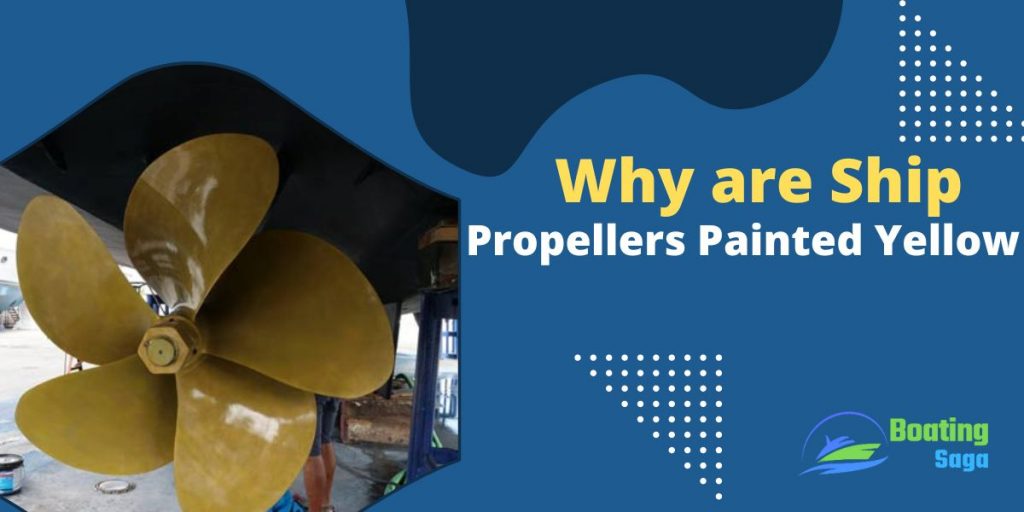
Ship propellers are typically painted yellow for a few reasons.
Why are ship propellers painted yellow?
Ship propellers are traditionally painted yellow because the color is thought to make them more visible to other vessels in low-light conditions. It is also said that the yellow paint makes the blades less visible to marine life, which can help reduce the number of animals that are injured or killed by the propellers.
Some Reasons are Ship Propellers Painted Yellow?
There are many reasons why ship propellers are painted yellow. Some reasons are for safety, to make the propeller more visible, and to help prevent corrosion.
One of the main reasons why propellers are painted yellow is for safety. If a propeller is damaged, it will be easier to see if it is painted yellow. So all accidents and injuries will be avoided.
Another reason why propellers are painted yellow is to make them more visible. When a ship is traveling in open water, it can be difficult to see the propeller. Painting the propeller yellow will help make it easier to see.
Finally, one of the main reasons why propellers are painted yellow is to help prevent barnacles and corrosion. Propellers can be affected by rust and corrosion, which can reduce their lifespan. Painting them yellow helps protect them from rust and corrosion.
What does the color yellow represent in ship propeller?
The color yellow is often used in ship propellers. The most common reason is that it makes the propeller more visible to those on shore or on other boats. This is important, especially at night or in bad weather, because it helps the crew know where the propeller is and avoid potential accidents.
Some believe that the color yellow also has a positive effect on the propeller’s performance, making it move more efficiently through the water. However, there is no scientific evidence to support this claim.
How the tradition of yellow ship propellers began?
The tradition of painting ship propellers yellow may have originated in the Royal Navy in the early 1800s. At that time, ships were painted black with yellow trim to make them easier to see at sea. The black paint helped to camouflage the ship from enemies, while the yellow paint made it stand out against the dark background. To make sure that the propellers were also painted yellow, sailors would often use lemon juice to spot and clean any areas that had been missed.
Today, almost all commercial ships have yellow propellers. This is done both for safety reasons and to make them more visible against the backdrop of blue ocean water. Some people believe that the tradition of painting ship propellers yellow began with a British naval vessel called HMS Camperdown. In 1849, Camperdown was involved in a battle with an Italian ship called the Roma.
In those days, there were no radios or other means of communication, so the yellow propellers became a visual signal to other sailors.
What are the benefits of painting a ship’s propeller yellow?
There are many benefits to painting a ship’s propeller yellow. The first is that it makes the propeller more visible. This is especially important when the ship is traveling in low light or foggy conditions.
Painting the propeller yellow also helps to keep it clean, as it can be easily spotted when debris and other objects start to build up on it.
Finally, painting the propeller yellow can help to protect it from corrosion.
Can You Use Any Paint For Propeller?

The simple answer is yes, you can use any type of paint to coat your propeller. Additionally, keep in mind a few things you’ll need to consider before making your decision.
The first thing to think about is the type of paint you’re using. Some paints are more durable than others, so you’ll want to make sure you choose a paint that can withstand the elements.
You should also consider whether the color of your paint will be right for your business. Most people choose a light color so they can see the propeller if it becomes submerged in water. However, if you’re using a brightly colored paint, make sure it’s in good condition and won’t chip or flake off over time.
What are the different colors of propellers?
A propeller is an important tool on a boat. It helps the boat move through the water. There are many different colors of propellers. Some people might think that all propellers are the same color, but there are many different colors of propellers.
The most common color of a propeller is yellow and black. This is because it blends in with the bottom of the boat and is less visible to other boats. However, there are also propellers in white, green, red, and blue. Some people might choose to buy a specific color propeller based on their boat’s color scheme or their favorite color.
White propellers are popular for fishing boats because they help to attract fish. Green propellers are popular for sailboats because they create less drag in the water and thus help the boat move faster.
Related Question:
Why does the color yellow have a special meaning for ships?
Ships have been using yellow flags since the early days of sailing. There are many theories as to why this color was chosen, but the most popular belief is that it is a way to indicate a ship’s propelling power.
The yellow flag was first used by the British Royal Navy in the 18th century. At that time, all warships were propelled by sails and oars. To indicate which ships were using sails and which were using oars, the sailors would fly a yellow flag from the mast of the ship with propulsion.
Today, ships still use yellow flags to indicate their propulsion type. However, it is no longer just for British Royal Navy ships. All navies around the world use yellow flags to indicate which ships are powered by sails or propellers.
Why do some ships have red propellers?
There is no one definitive answer to this question. Some people say that it is because red is the color of danger, and therefore a warning to other ships. Others say that it is simply because red propellers are more visible in poor weather conditions.
While there is no clear evidence to support either explanation, it is likely that both explanations have some truth to them. Red propellers may be used as a warning signal, or they may be more visible in bad weather conditions, making them less likely to be run into by other ships.
Brush paint vs Spray paint for boat propeller: which is the best?
The debate of brush paint vs spray paint for a boat propeller can be summed up with two words: precision and protection. When it comes to boats, every detail is important, and the propeller is no exception.
A brush can provide the precision needed to get into all the nooks and crannies of the propeller, ensuring that every blade is well-coated. In addition, a brush allows for better control over the amount of paint being used, which is important when working with a valuable piece like a propeller.
Spray paint, on the other hand, offers more protection from the elements. It coats more surface area quickly and evenly, providing better coverage against rust and corrosion. Additionally, spray paint is less likely to drip or run than brush-applied paint.
Best paint for boat propellers

If you are looking to buy a new boat propeller, or need to get your current one repainted, you may be wondering what the best paint for a boat propeller is. There are a few different types of paint that can be used on boat propellers, but the two most common ones are epoxy and polyurethane.
Epoxy is a strong and durable coating that can withstand high temperatures and is resistant to corrosion.
Polyurethane is also a durable coating, but it is not as heat resistant as epoxy. Both epoxy and polyurethane coatings can be applied using spray cans or airless sprayers.
Conclusion
The yellow paint on ship propellers serves a few important purposes. It helps to keep the propeller cooler, making it less likely to overheat and damage the engine. It also makes the propeller more visible in foggy or dark conditions. By painting the propeller yellow, ships can avoid accidents and minimize damages.


